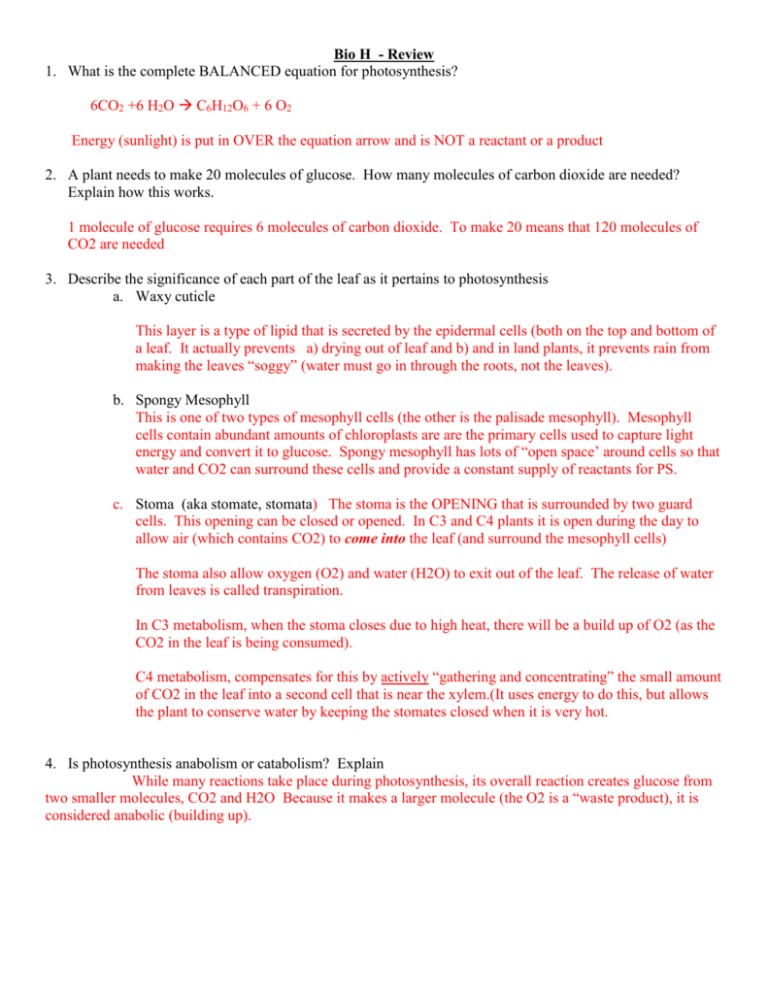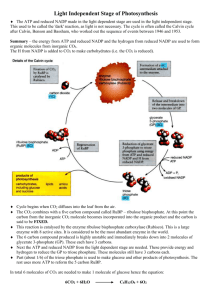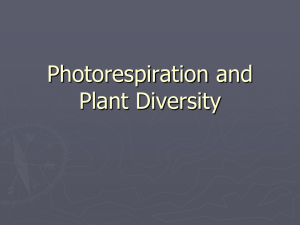Practice test:
advertisement

Bio H - Review 1. What is the complete BALANCED equation for photosynthesis? 6CO2 +6 H2O C6H12O6 + 6 O2 Energy (sunlight) is put in OVER the equation arrow and is NOT a reactant or a product 2. A plant needs to make 20 molecules of glucose. How many molecules of carbon dioxide are needed? Explain how this works. 1 molecule of glucose requires 6 molecules of carbon dioxide. To make 20 means that 120 molecules of CO2 are needed 3. Describe the significance of each part of the leaf as it pertains to photosynthesis a. Waxy cuticle This layer is a type of lipid that is secreted by the epidermal cells (both on the top and bottom of a leaf. It actually prevents a) drying out of leaf and b) and in land plants, it prevents rain from making the leaves “soggy” (water must go in through the roots, not the leaves). b. Spongy Mesophyll This is one of two types of mesophyll cells (the other is the palisade mesophyll). Mesophyll cells contain abundant amounts of chloroplasts are are the primary cells used to capture light energy and convert it to glucose. Spongy mesophyll has lots of “open space’ around cells so that water and CO2 can surround these cells and provide a constant supply of reactants for PS. c. Stoma (aka stomate, stomata) The stoma is the OPENING that is surrounded by two guard cells. This opening can be closed or opened. In C3 and C4 plants it is open during the day to allow air (which contains CO2) to come into the leaf (and surround the mesophyll cells) The stoma also allow oxygen (O2) and water (H2O) to exit out of the leaf. The release of water from leaves is called transpiration. In C3 metabolism, when the stoma closes due to high heat, there will be a build up of O2 (as the CO2 in the leaf is being consumed). C4 metabolism, compensates for this by actively “gathering and concentrating” the small amount of CO2 in the leaf into a second cell that is near the xylem.(It uses energy to do this, but allows the plant to conserve water by keeping the stomates closed when it is very hot. 4. Is photosynthesis anabolism or catabolism? Explain While many reactions take place during photosynthesis, its overall reaction creates glucose from two smaller molecules, CO2 and H2O Because it makes a larger molecule (the O2 is a “waste product), it is considered anabolic (building up). 5. We used a roller coaster as an example of how energy is transformed. a. A person measures the cars as having 300 units of energy at the top and 235 units as it travels down the hill but the track feels warm afterward and there were sparks as the coaster rolled over the tracks. The person makes the conclusion that some of the energy is lost. Explain why this is wrong and provide examples of where the energy goes. Energy is never created nor destroyed. In this case, the person is using the word lost as “disappeared” or destroyed . He/she could have said (correctly) that it is converted to thermal energy and “lost to the system” (meaning the roller coaster), because it can no longer be utilized within the system (it is now “heat in the universe”). What is important is that energy cannot be recycled in the system (like matter is) so while it is still present, it is now unusable. 6. We discussed 2 energy molecules that cycle from high energy and low energy and back during the process of photosynthesis. Diagram the cycles of 2 of those energy molecules. Make sure to indicate what is being added/removed and where the energy is going/coming from. Energy in this reaction can also come from the sun (in plants) in addition to food While this is a picture of NAD and not NADP All electron carriers are reduced (meaning electrons and hydrogen ions are added). Hydrogen and eare generated from the breakdown of water in the light reactions. NADPH reduces carbon compounds to ultimately produce G-3-P (2 of which join to make glucose) 7. Explain why, even though most humans eat primarily meat, it is safe to say that our energy technically comes from the sun. Even when we eat meat, that animal either consumed plants, or ate another animal that contained plants. Because the food chain for all animals starts with consumption of a producer (which uses the sun to make glucose and the organic molecules in plants (such as lipids, starches and proteins). We ultimately make our ATP from an organic molecule that was made because of the stored energy in organic compounds in plants. 8. Name the two types of tissue in plant veins and identify what each one carries. Xylem – water Phloem – glucose (food) 9. Explain what would happen to the following if the stoma of a leaf were to close: a. CO2 levels inside the leaf: When stoma are closed, the available CO2 in the leaf is utilized and O2 is produced (when sun is out). Since “new” CO2 from the air cannot come in, therefore CO2 (reactant) Is not available. RESULT: PS decreases or stops. b. H2O levels inside the leaf: Water levels will “concentrate (if water is available from the roots) in the leaf if stoma are closed since transpiration will not occur. c. Oxygen Levels inside the leaf: Oxygen levels will increase. While you may think that O2 can diffuse out of the leaf, in reality, it cannot due to the cuticle. In a C3 plant, lack of CO2 with an increase in O2 will result in photo-oxidation (which means that the Calvin cycle will fix O2 and not CO2 no glucose. C4 plants will concentrate the CO2 that is within and between the mesophyll cells and actively transport the CO2 to the cells surrounding the xylem. Energy is used, BUT…more glucose can be made even when stomatas are closed. 10. Why types of plants had to evolve special adaptations to compensate for the fact that their stoma have to be kept closed often to prevent water loss? C4 plants concentrate low levels of CO2 existing in the leaf when stomates are closed and prevent loss of water. This allows PS to go on. (grasses, corn) CAM plants store light energy in compounds that are kept in the vacuoles. This means that light reactions take place during the day and the energy is stored (but CO2 is not fixed). At night, when desert temperatures cool (and therefore transpiration occurs at a lower rate), stomata open and the carbon fixation cycle takes place (cacti) 11. Carotenoids absorb light of approximately 435nm, 475nm and 500nm. Label the line above that represents the carrotenoids. (see above) 12. Chlorophyll A absorbs light of approximately 400 and 430. Label the line above that represents the chlorophyll A. (see above) 13. Why doesn’t the graph show pigments absorbing light below 400 or above 700? Plant pigments do not absorb outside the 400-700 nm range 14. Where are all the enzymes of the light reactions located? On the thylakoid membranes. The ones you need to know are NADP reductase and ATP synthase. 15. Where are all the enzymes of the calvin cycle located? In the stroma. The most important enzyme and you must know this is Rubisco. This is the most prevalent enzyme in the world. (ribulose-1,5-bisphosphate carboxylase/oxygenase = rubisco) 16. Draw a diagram of both the mitochondria and the chloroplast a. Using arrows and chemical formulas indicate how the products of one can become the reactants of the other. b. Show how the energy flows THROUGH the system Sunlight has energy. Energy - ATP and NADPH then to Glucose (chloroplasts) Glucose energy is put into ATP and NADH and FADH which eventually are converted to ATP. For each conversion, some energy (in the form of thermal energy (is lost). Eventually all energy converts to thermal energy (as things are synthesized and deconstructed) 20. Is the energy “recycled” or is it uni-directional? Explain. Unidirectional…because some energy captured from the sun is “lost” (converted to thermal energy) in each reaction, it cannot be “reused”. 21. What is an electron carrier? What purpose do they serve? Give 3 examples? A molecule that accepts and donates pairs of electrons and H+. The purpose of these carriers is to transport electrons to the ETC (so that energy can be transferred to ATP molecules). NADPH works with ATP in the Calvin cycle (photosynthesis) to reduce CO2 to form glucose (adds hydrogens, electrons (and energy) to glucose. 22. What are the advantages of having multiple pigments as opposed to having lots of one type of pigment? The ability to absorb energy from many wavelengths (and thus increase the total energy absorbed from the sun. 23. Plants perform more photosynthesis than they do cell respiration. a. What are two pieces of evidence that support this statement? Plants perform both cellular respiration and PS. If they only made enough for themselves, there would be no O2 in the atmosphere. Humans breathe in the same amount of CO2 that is expired (as do many other organisms), however, the planet maintains its Oxygen content in the air (despite the fact that plants are decreasing and animals are increasing in number) b. Why does the plant do this excess work? It is actually making and storing food for itself (and to reproduce). The glucose is used to feed the plant (and to help the plant to grow and reproduce. c. How is it advantageous to us? We eat parts of the plant…and we breathe., and we have a varied diet (many forms of carbs, lipids and proteins due to having plants as a “base” for our energy consumption. SEE ADDITIONAL STUDY GUIDE. MORE TO KNOW: I just realized that there is really not much on Respiration (or fermentation) on this study guide. You should know that fermentation is used to regenerated NAD+ from NADH (we need to do this in order to generate more ATP. You need to utilize the charts that I gave you to study from 1. The diagram (anaerobic and aerobic, steps, locations, etc.) Compare energy production 2. The Table (know the endproducts and electron carriers. You need to be able to describe how PS and Resp are “reverse steps” ELECTRON TRANSPORT Light reactions (and its electron transport chain) on the thylakoid membrane vs. ETC in respiration (on the cristae membrane) FIXATION of CO2 and OXIDATION to form CO2 Calvin cycle adds hydrogens and electrons Krebs takes out hydrogens and electrons from CO2 glucose glucose CO2 Calvin cycle ends with G-3-P, a 3-carbon compound (glucose is created later outside the chloroplast. Calvin cycle takes place in the fluid filled area of the chloroplast. Glucose is converted to pyruvate (a 3 carbon compound) in the cytoplasm. (glycolysis) Krebs cycle uses a 3 C pyruvate and disassembles it to yield CO2 + electron carriers and ATP Then the 3 C compound is broken down to CO2 within the matrix(fluid filled area) of the mitochondria.









